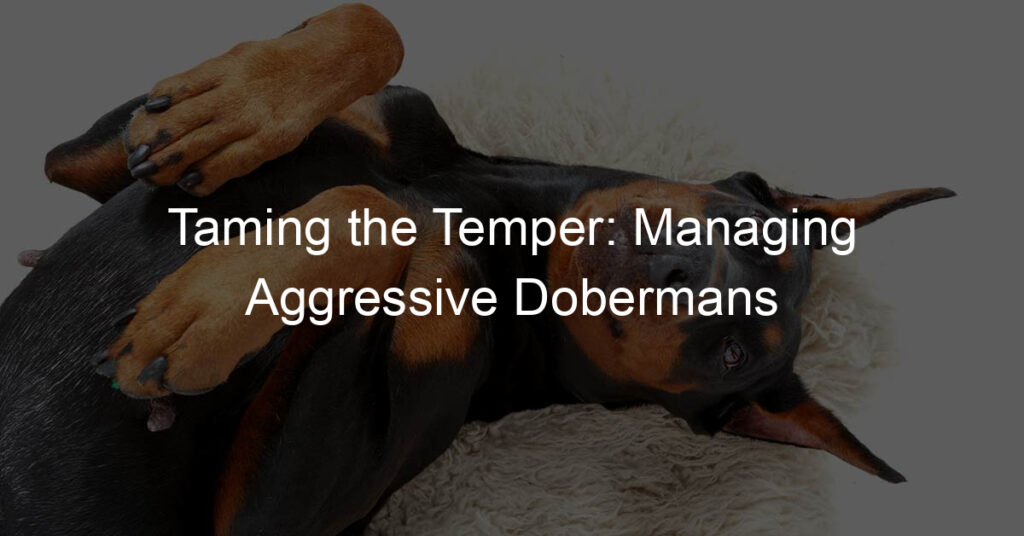
Introduction: Understanding Doberman Behavior
Dobermans are known for their loyalty, intelligence, and strong protective instincts. However, like any breed, they can exhibit certain behavioral issues. Understanding these behaviors is the first step towards resolving them and ensuring a happy, healthy relationship with your Doberman.
- The nature of Doberman behavioral problems
- Importance of resolving Doberman issues
Dobermans are naturally energetic and require regular exercise to keep them mentally and physically stimulated. Lack of exercise can lead to destructive behaviors such as chewing, digging, and excessive barking. They can also exhibit aggressive behavior if not properly socialized or trained from a young age.
Resolving these behavioral issues is crucial for the well-being of both the Doberman and its owner. Unresolved issues can lead to stress, anxiety, and even health problems for the dog. For the owner, it can lead to frustration and a strained relationship with their pet. Moreover, it’s important for the safety of others as well, as an uncontrolled Doberman can potentially pose a threat due to its size and strength.
Understanding and addressing Doberman behavior issues not only improves the quality of life for the dog, but also strengthens the bond between the dog and its owner. In the following sections, we will delve deeper into how to tackle these issues and provide practical solutions based on real-life case studies.
Tackling Doberman Woes: A Comprehensive Guide
Dobermans are known for their intelligence, loyalty, and protective nature. However, they can also present certain challenges in training and behavior management. In this guide, we will explore some effective strategies to tackle common Doberman woes.
Doberman Training Tips
Training a Doberman requires patience, consistency, and a clear understanding of their behavior. Here are some tips to help you train your Doberman effectively:
- Establishing Dominance
- Consistent Training Schedules
- Positive Reinforcement Techniques
Dobermans are naturally dominant dogs. It’s important to establish yourself as the pack leader from the start. This doesn’t mean being harsh or aggressive. Instead, it involves setting clear boundaries and rules, and consistently enforcing them.
Consistency is key when training a Doberman. Establish a regular training schedule and stick to it. This helps your Doberman understand what is expected of them and reinforces good behavior.
Positive reinforcement involves rewarding your Doberman for good behavior. This can be in the form of treats, praise, or extra playtime. This encourages your Doberman to repeat the behavior, making training more effective.
Remember, every Doberman is unique and what works for one may not work for another. It’s important to be patient and flexible in your training approach.
Doberman Behavior Management
Managing the behavior of your Doberman is a crucial part of ensuring a happy and healthy pet. This involves understanding their triggers, creating a stress-free environment, and implementing proper socialization methods. Let’s delve into these aspects.
- Understanding Triggers
Every Doberman has unique triggers that can lead to unwanted behavior. These triggers can be anything from loud noises to unfamiliar people or animals. It’s important to identify these triggers and manage them effectively. For example, if your Doberman gets anxious around strangers, you might need to introduce new people slowly and in a controlled environment.
- Creating a Stress-Free Environment
A stress-free environment is key to managing your Doberman’s behavior. This includes providing them with a safe space where they can relax and feel secure. Make sure their bed is comfortable and their toys are accessible. Keep their environment clean and free from loud noises or sudden changes. A calm and predictable environment can greatly reduce stress and anxiety in Dobermans.
- Proper Socialization Methods
Socializing your Doberman from a young age is essential for their behavior management. This involves exposing them to different people, animals, and environments in a positive and controlled way. Regular walks in the park, play dates with other dogs, and visits to pet-friendly stores can be great ways to socialize your Doberman. Remember, the goal is to help them feel comfortable and confident in various situations.
In conclusion, understanding your Doberman’s triggers, creating a stress-free environment, and implementing proper socialization methods are key strategies in managing their behavior. With patience and consistency, you can help your Doberman become a well-behaved and happy member of your family.
Solutions for Doberman Issues: Case Studies
In this section, we will explore some real-life examples of how common Doberman issues have been successfully managed. Our first case study focuses on dealing with aggression in Dobermans.
Case Study 1: Dealing with Aggression
Aggression can be a challenging issue to deal with in Dobermans. Let’s take a look at how one pet owner managed to address this problem effectively.
- Identifying the cause
- Implementing a behavior correction plan
- Results and key takeaways
The first step was to identify the cause of the aggression. In this case, the Doberman, named Max, was showing signs of aggression when he was around other dogs. After observing Max’s behavior and consulting with a professional dog trainer, it was concluded that Max’s aggression was due to fear and insecurity around other dogs.
Once the cause was identified, a behavior correction plan was put into place. The plan included socialization training, where Max was gradually introduced to other dogs in a controlled environment. The owner also used positive reinforcement techniques, rewarding Max for calm behavior around other dogs.
After several weeks of consistent training, Max’s aggression significantly reduced. He became more comfortable around other dogs and showed less signs of fear and insecurity. The key takeaway from this case study is that understanding the root cause of aggression is crucial in addressing it. Also, a well-structured behavior correction plan, coupled with patience and consistency, can yield positive results.
In conclusion, dealing with aggression in Dobermans can be challenging, but with the right approach, it is manageable. Identifying the cause, implementing a behavior correction plan, and being patient and consistent are key to success.
| Problem | Solution | Result |
|---|---|---|
| Aggression in Dobermans | Identifying the cause and implementing a behavior correction plan | Significant reduction in aggressive behavior |
Case Study 2: Overcoming Separation Anxiety
Separation anxiety is a common issue among Dobermans, and it can lead to destructive behavior if not addressed promptly and effectively. In this case study, we will explore how a specific obedience training regimen helped a Doberman overcome this issue.
- Understanding the issue
- Applying Doberman obedience training
- Results and key takeaways
Separation anxiety in Dobermans is characterized by excessive distress when left alone. Symptoms can include excessive barking, chewing, and even self-injury. This behavior is often triggered by a change in the dog’s routine or environment, such as a move to a new home or the absence of a family member.
Training a Doberman to overcome separation anxiety requires patience and consistency. The process involves gradually increasing the amount of time the dog spends alone, starting with just a few minutes and gradually increasing to several hours. This training should be paired with positive reinforcement, such as treats or praise, when the dog behaves appropriately while alone.
| Training Steps | Duration |
|---|---|
| Start with short separations | 5-10 minutes |
| Gradually increase separation time | 15-30 minutes |
| Introduce longer separations | 1-2 hours |
After several weeks of consistent training, the Doberman in this case study showed significant improvement. The dog was able to stay alone for several hours without exhibiting signs of distress. This case study highlights the importance of understanding the root cause of a dog’s behavior and the effectiveness of consistent, positive reinforcement training.
In conclusion, overcoming separation anxiety in Dobermans is achievable with understanding, patience, and consistent training. It’s crucial to remember that every dog is unique, and what works for one may not work for another. Therefore, it’s important to tailor your approach to your dog’s specific needs and behaviors.
Conclusion: Mastering the Mayhem
As we wrap up this comprehensive guide on dealing with Doberman issues, it’s important to reflect on the key insights we’ve gathered. Let’s take a moment to recap and understand how we can master the mayhem that sometimes comes with owning a Doberman.
- Recap of tackling Doberman woes: Throughout this guide, we’ve discussed various problems that Doberman owners often face, from aggression to anxiety, and offered practical solutions for each. We’ve learned that patience, consistency, and proper training techniques are crucial in managing these issues. Remember, every Doberman is unique, and what works for one might not work for another. It’s all about understanding your pet and adapting your approach accordingly.
- Importance of understanding Doberman behavior: Understanding your Doberman’s behavior is the first step towards resolving any issues. Dobermans are intelligent, energetic, and loyal dogs. They require mental stimulation, physical exercise, and a lot of love and attention. By understanding their needs and behavior, you can create a positive environment that encourages good behavior and reduces the likelihood of problems arising.
- Final thoughts on dealing with Doberman problems: Dealing with Doberman problems can be challenging, but it’s not impossible. With the right knowledge and approach, you can turn the tide and create a harmonious relationship with your Doberman. Remember, it’s not about controlling your Doberman, but about understanding and guiding them. As the saying goes, “The more you know about your dog, the better you can provide for them.”
In conclusion, mastering the mayhem of Doberman ownership is all about understanding, patience, and love. It may be a bumpy ride at times, but the reward of a loyal and loving companion is well worth the effort. So, here’s to you and your Doberman, may you both have many happy and peaceful years together!








